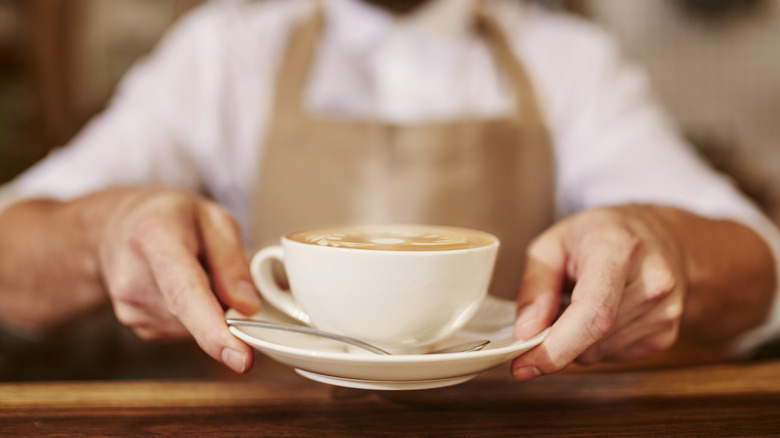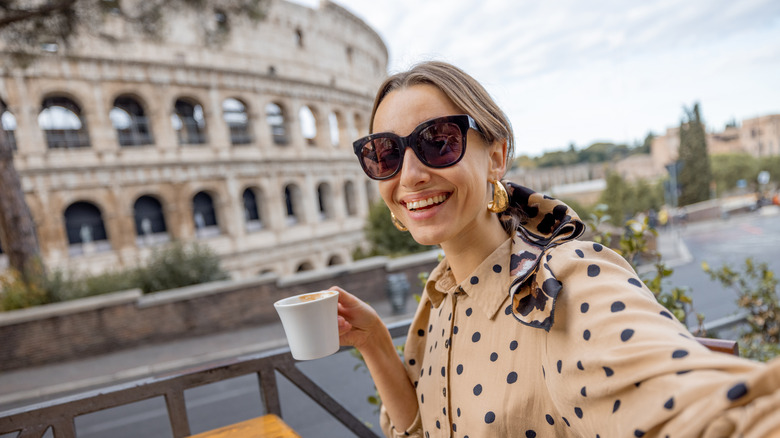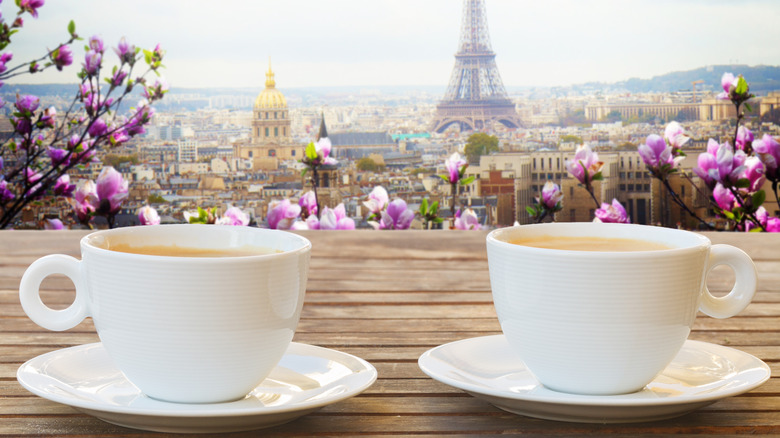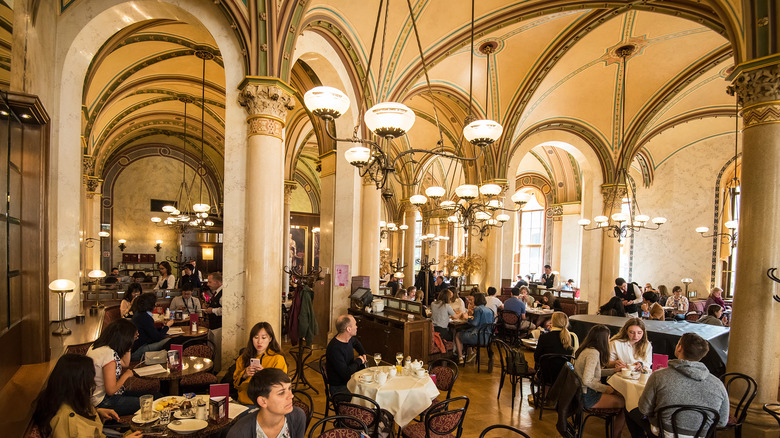How To Order Coffee In Europe Without Sounding Like A Tourist
For so many of us, there's just no getting through the day without coffee. It gets us out of bed, sits on the desk while we sift through emails, and comes with us everywhere in to-go cups. In the United States, coffee culture is pretty much a whatever-we-want, whenever-we-want-it kind of mentality. Whether lattes, cold brews, or custom drinks made with alternative milk, flavorings, and foam, American coffee lovers indulge in any drink that strikes their fancy, morning, noon, or night.
When traveling abroad Americans are often surprised to find that the rules of coffee look different than they do at home — the first surprise is that there are rules to coffee at all! That's because in many countries coffee is more than just a cup of liquid ambition; it's a part of centuries-old customs that are a facet of residents' identities just like the language they speak and the place they grew up. Ordering coffee as you do in the United States will not only immediately peg you as a tourist, but may also earn you odd looks, confusion, and even a few sneers from the locals.
To really blend in and experience the culture, here are a few things to know when ordering coffee abroad in some of the countries where visiting a café is a favorite bucket list item for travelers.
Ordering coffee in Italy
For coffee in Italy, don't ask for a café — look for a bar. This is confusing for Americans, but bars there are not for throwing back beers; bars are where locals get their coffee along with pastries, sandwiches, and evening aperitivos. They're easy to find with signs that clearly say "Bar" and sometimes "Caffè." Once there, drink your coffee like a local: while standing up at the counter — and don't linger. Most Italian bars will tack on an upcharge for the luxury of sipping coffee leisurely at a table.
At a bar there is no drip coffee option; the most basic order is a caffè normale, a single shot of espresso. For a weaker coffee, Americans can be brave and order an americano (watered-down espresso,) but doing so risks an eye roll from the barista. Locals instead order a caffè lungo, a longer-pull, milder espresso. Also, Italians don't usually order a doppio or double-shot; they drink a single espresso and then order a second.
Americans can enjoy a classic cappuccino in Italy, but only with breakfast. Italians feel that the milky drink interferes with digestion when consumed later in the day. A caffè latte is another breakfast coffee, however, don't refer to it as simply a "latte" — that will get you a plain glass of milk.
For an afternoon caffeine fix, a macchiato or caffè freddo (espresso shaken with ice and sugar) are Italian favorites. Appropriate evening coffee choices include an espresso or a caffè corretto: espresso with liqueur.
Be polite when ordering coffee in France
Unlike in Italy, coffee is served in cafés in France, as well as in brasseries. French cafés have an upcharge for coffee at a table, but the good news is that once you're seated, it's totally acceptable to lounge there as long as you'd like. For a faster caffeine boost, drink your coffee inside standing at the bar, and mingle with the waiters and locals.
A basic French coffee order is un café, a single shot of espresso. Some cafés offer weaker options, like café filtre (filtered coffee) or café allongé which is the same as an Americano. However, if the goal is to not look like a tourist, then don't ask for either of these.
Requesting a side of milk is also a no-no. Instead, order a drink that is made with milk, such as a noisette or cappuccino. As in Italy, these milky drinks are traditionally for breakfast only. You may order a café crème (espresso with milk) but never order a café au lait — unless you're trying to flirt with the waiter. While technically the same drink, café au lait is a morning coffee that locals sip at home.
Most important of all, the French really bristle at rudeness, another trait that will identify you as a tourist. This could be as simple as not saying please when ordering, or something more obnoxious like waving or yelling at a waiter to get service. So act like a local: Be patient with the slower pace, and generous with your pleases (s'il vous plaît) and thank yous (merci.)
More countries with coffee cultures worth experiencing
To grab a coffee at an American chain like Starbucks or McDonald's in European countries is a surefire way to stand out as a tourist, and to miss out on picturesque cafes with exquisite drinks and food. Many countries in Europe have rich coffee cultures worth experiencing. Just as when visiting Italy and France, the point is not to get the exact cup of joe you'd have back home, but to enjoy it just as the locals do.
Head to the coffee houses of Vienna, Austria, many of which boast ornate rooms with pillars, fine art, and formally attired waiters. Do as the locals do: linger for hours or an entire day over treats like an einspänner (espresso with whipped cream) and a slice of Sacher torte. You'll be participating in a tradition that was a favorite of historical figures like Sigmond Freud, Leon Trotsky, and Ludwig von Beethoven, according to Cafe Central and Visiting Vienna.
In Sweden, coffee breaks are so sacred they have their own name: fika. Fika is a time for a coffee, pastries like kanelbullar (cinnamon buns), and most importantly for slowing down and chatting with friends. Best of all, locals indulge in fikas any time of day. Similarly, in Germany, they also love coffee paired with pastries; these late-afternoon breaks are called a kaffeeklatsch. If you get the chance, try the German coffee drink called pharisäer kaffee, a tall glass of hot coffee with a shot of rum topped with whipped cream.
Visiting cafes in Europe is a fantastic way to experience local flavor — no museum pass or guided tour necessary! But do so like a local who understands that coffee is more than just a Monday pick-me-up; it's part of a time-honored tradition of slowing down and savoring life.



